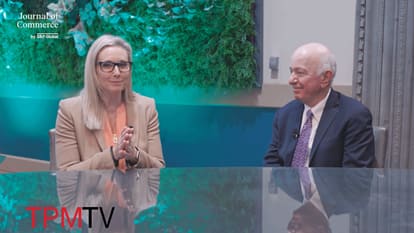- Program
- What's New
- Speakers
- Who's Attending
- TPM Community
- Partners

TPM Partnership
Partnership places your company in a position of authority and enables you to build and strengthen your relationships, visibility and reputation with major shippers
LEARN MORE - Media

TPM TV
Episodes of exclusive TPM content featuring interviews of key stakeholders and attendees.
WATCH NOW - About

About TPM
The must-attend conference for the trans-Pacific and global container shipping and logistics community
LEARN ABOUT TPM - Get Updates
- FAQ's
Post-TPM24 Cold Chain Q&A with Thomas Eskesen
April 01, 2024
Thomas Eskesen, the former Maersk global head of refrigerated shipping, founder of Eskesen Advisory, and chairman of TPM Cold Chain, shares his thoughts after the inaugural TPM Cold Chain track at TPM24 in this interview recorded on Mar. 21.
As Chairman TPM Cold Chain, you have a unique overview of the key trends, risks and opportunities going forward. What were the highlights of this year?
Let me start with the overall context for global shippers, which is major geopolitical turmoil with two regional wars (Ukraine and Gaza) and two main canal transit arteries heavily affected. Suez delay contingencies have moved from week to week planning to a more dire realisation that this may well continue for several quarters if not into 2025. The Panama Canal restrictions which are ongoing relate to El Nino and should hopefully normalize later in the year, but even that is not guaranteed.
Secondly, if we draw some lessons from Covid in 2020, cold chain supply chains are greatly affected by one Black Swan event after another let alone growing global weather challenges. Some key implications for shippers and suppliers are:
A) It’s not enough to just have a Plan B or even Plan C. BCOs must plan for the unknown. As one speaker said, every big event becomes a US$1 million plus challenge either in terms of added cost of lost sales of their perishables goods
B) Cold chain logistics is now firmly a CEO and board room agenda which means more investments are going into IT visibility platforms and exception management
C) Shippers need to treat their suppliers far more strategically and have solid relationships in place so when things go wrong like a port closure in Haiti, potential ILA disruptions later in the year on US East Coast, action can be taken quickly and jointly.
So ultimately we predict a massive shift in how actors in the global as well as domestic/regional cold chain collaborate. Players simply can’t fix things in silos but rather must truly collaborate.
Who spoke at the conference and who was in the audience?
For the program we deliberately picked cold chain executives from all sectors of the entire ocean containerized cold chain. It is part of our plan to build the world’s number 1 containerized cold chain event, within TPM. We prioritized global trends and experiences for context and then included various deep dives to beyond the headlines into the real world of containerized cold chains. Shippers included Walmart, AJC, Pacific Seafoods, Mary Kay, Driscolls. Maersk, Cosco and Hapag were represented with their top global cold chain executives. On the asset side we had leading US reefer port CEOs from Philadelphia, Port Hueneme , JB Hunt as well as global players like Americold , DP World and Seacube leasing. We also had a tech session with interesting speakers from Orbcomm, Gnosis and Candor. Cold chain also featured at the TPM Academy, a first.
Global trends and forecasting where delivered from Seabury and S&P Global ensuring we had a shared view on markets and data including the implications of the Suez Canal/Red Sea cascading effect for global trade. Forecasting is increasingly difficult but data is essential for scenario planning the “what ifs”.
TPM Cold Chain was also the platform for the first broader launch of the Move to - 15c coalition, a major initiate to change the temperature of frozen food from -18c to -15c to substantially reduce carbon emissions without affecting food safety. How did it go?
The launch at TPM of the pledge to -15c was actually perfectly timed on the back of COP28 in Dubai where the Move to -15c coalition was announced. The first -15c members meeting was held in conjunction with TPM24. The science has demonstrated significant CO2 savings if we all increase temperatures from minus 18c—a nearly century old standard -- to minus 15c. According to research by DB World, changing this standard would cut annual emissions by 17.7 million tonnes of CO2 a year, equivalent to the carbon emitted by 3.8 million cars, while generating 5-7% energy savings across the entire cold chain, without impacting food or product safety.
In conjunction with TPM24 I chaired the first -15c members meeting where we discussed industry collaboration, how to gain quick wins, how to deal with legislators, risk and opportunities for something so bold yet so simple! We are just getting started and strongly encourage more to join the coalition. Learn more here.
Where do we go from here with TPM Cold Chain?
In summary it was an excellent TPM24 but we are not stopping here. Our clear ambition, among S&P Global, Journal of Commerce and Eskesen Advisory, is to become the premier global end-to-end ocean containerized cold chain conference and a must-attend event. We are off to a great start and I think the combination with the overall TPM event makes the context, content and networking totally unique, where there is no where else where you find such a great value proposition.
{
"dots": false,
"autoplay": true,
"autoplaySpeed": 6000
}
About the Journal of Commerce
The Journal of Commerce is produced by a team of specialized, subject-matter expert journalists providing original daily news analysis of international logistics for corporate logistics teams and other participants in global supply chains. We are accountable to paying subscribers who demand that our news and analysis be accurate, fair, independent, and informative. Part of S&P Global, the editorial team leverages extensive data assets and relationships built over many years throughout trade and transportation to deliver trusted, executive-level insights relied upon by senior logistics executives. The Journal of Commerce group builds on its expertise and source relationships to develop industry-leading conferences including TPM, Breakbulk, and Inland Distribution.
